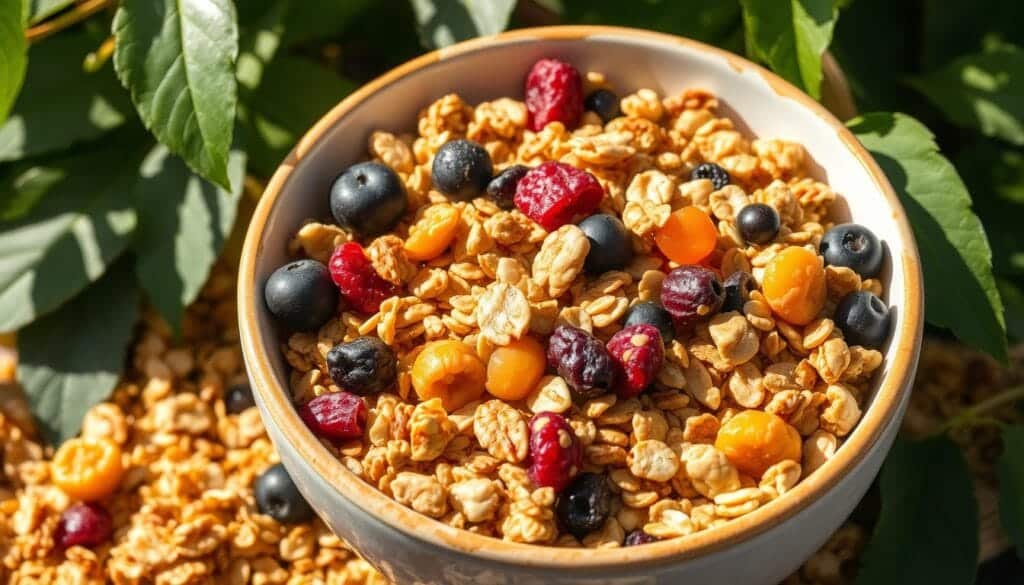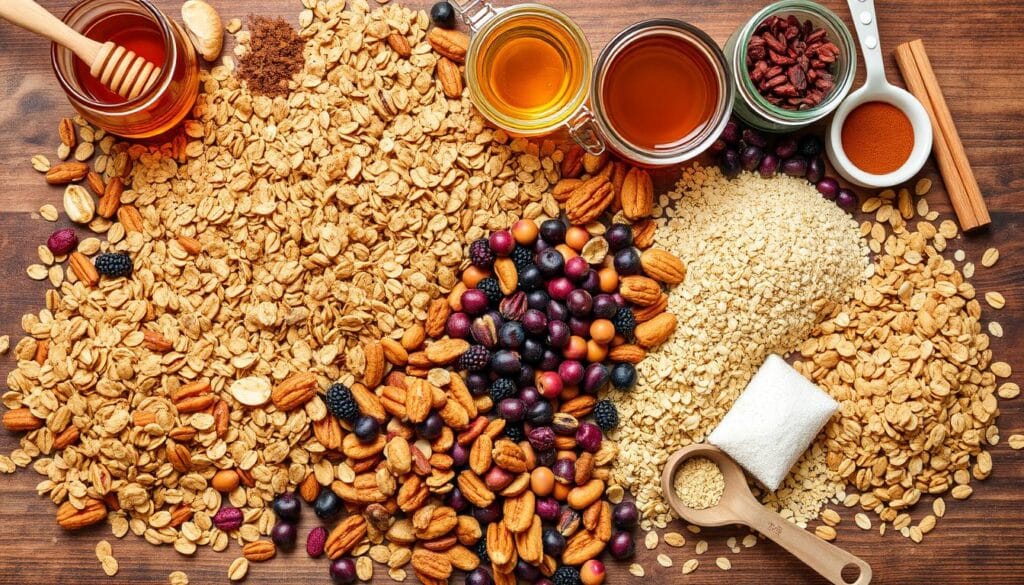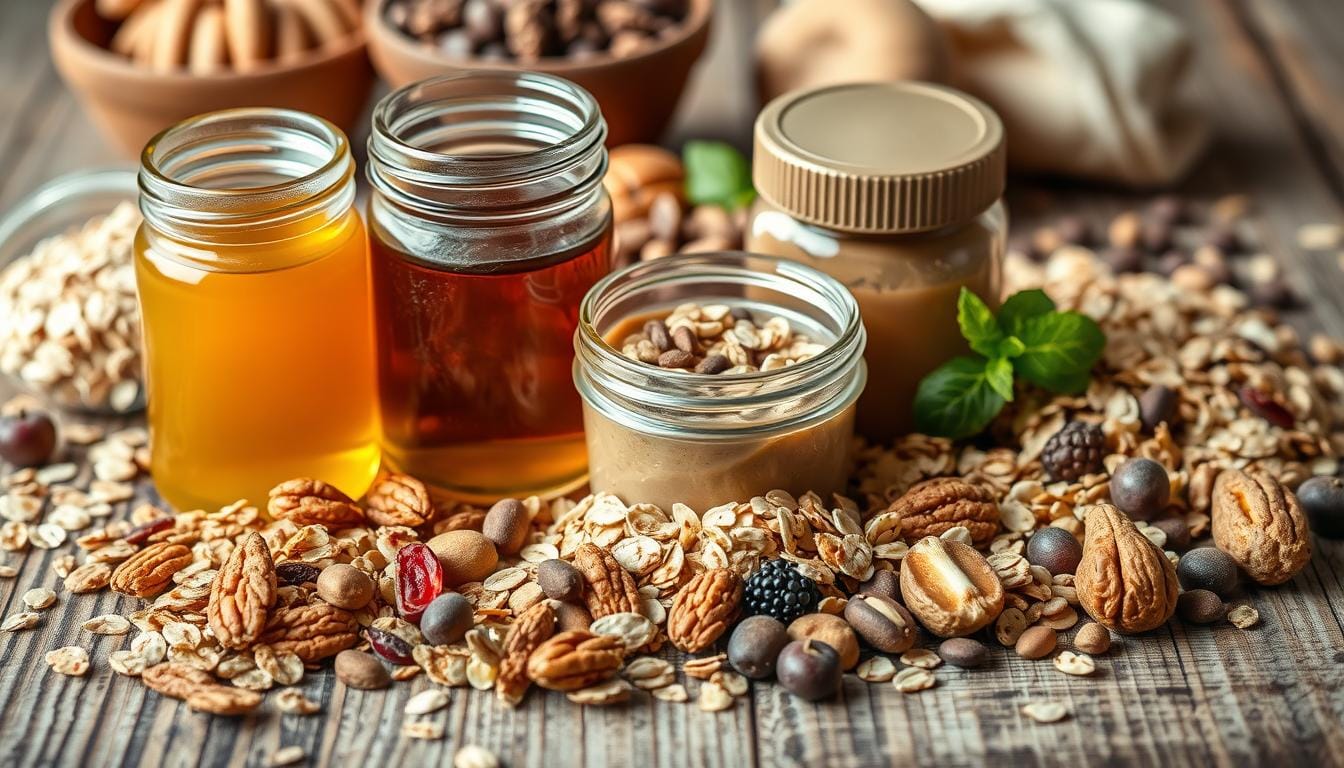As I poured the freshly baked granola into a bowl, the delightful aroma of toasted oats and warm spices wafted through the air, making my mouth water in anticipation. The rustic texture and golden-brown clusters were undeniably tempting, but what was the secret ingredient that kept those crunchy morsels perfectly bound together? It’s a question many granola enthusiasts ponder: What ingredient makes granola stick together? While honey and maple syrup often steal the spotlight, there’s an unsung hero that plays a crucial role in achieving that ideal clumpiness—vegetable oil. Granola has become a beloved staple in breakfast bowls and snack bars alike, celebrated for its delightful balance of textures and flavors. But have you ever wondered, “What ingredient makes granola stick together?”
Key Takeaways
- Discover the essential ingredients that make granola stick together, including honey, maple syrup, and nut butters.
- Learn how the science of binding agents affects the texture and structure of homemade granola.
- Explore healthier alternatives to traditional sweeteners and binding agents for a more nutritious granola.
- Uncover tips for achieving the perfect balance of crunch and chewiness in your granola recipes.
- Discover effective storage and reheating methods to keep your homemade granola fresh and flavorful.
Understanding Granola Composition
Granola is a favorite breakfast food in America, loved for over a century. It was created by Dr. John Harvey Kellogg, a health pioneer from the 19th century. Today, it’s known for its crunch, flavor, and health benefits.
Common Ingredients in Granola
Granola usually starts with rolled oats. It also includes other healthy ingredients like:
- Nuts such as almonds, walnuts, pecans, and cashews
- Seeds like sunflower, chia, pumpkin, and flaxseeds
- Dried fruits like raisins, cranberries, apricots, dates, and blueberries
The Role of Oats in Granola
Oats are the heart of granola, offering a dense and nutritious base. They come in different forms like rolled, steel-cut, or instant. Oats give granola its crunch and are packed with fiber, fats, and vitamins.
The Importance of Sweeteners
Sweeteners are crucial in granola, helping it stick together and adding flavor. Honey, maple syrup, and brown sugar are common choices. These natural sweeteners balance the taste and make the granola stick well.
Combining oats, nuts, seeds, fruits, and sweeteners is key to great granola. By knowing what makes up granola, you can try different mixes to find your favorite.
The Science Behind Binding
The binding process in granola is quite interesting. It involves the caramelization of sweeteners like honey, maple syrup, and brown sugar. When these sweeteners are heated, they go through chemical changes. This creates a hard, crisp coating around the oats and other ingredients.
Oils, such as coconut or avocado oil, are key in binding. They help spread heat evenly. This ensures the granola cooks well and the ingredients stick together. Nut butters, like peanut or almond butter, also help bind. They add a nutty flavor to the granola.
How Ingredients Interact
The mix of dry and wet ingredients is important for the right texture. Sweeteners, oils, and binders need to be mixed well. Fruit purees, like applesauce or mashed banana, add moisture. Nut butters and egg whites help the ingredients stick together.
The Role of Heat in Binding
The baking process is where the magic happens. Heat caramelizes the sweeteners and bonds the ingredients. As it bakes, the sugars and fats melt into the oats. This creates a solid structure.
Understanding the science behind binding helps make perfect homemade granola. Try different ingredients and baking methods. Find the mix that you enjoy the most.
“The caramelization of sugars and the Maillard reaction are the key to unlocking the complex flavors and textures in granola.”
Key Binding Ingredients
Creating granola that sticks together is all about the right ingredients. Sweeteners like honey, maple syrup, and agave nectar add flavor and help it stick. Nut butters like almond or cashew butter also help hold it together. And coconut oil makes it crunchy.
Honey: A Natural Binder
Honey is great for granola because it’s sticky. When it bakes, it caramelizes and makes the oats, nuts, and seeds chewy. Its sweetness also enhances the flavors in your honey granola.
Maple Syrup vs. Agave Nectar
If you’re looking for a vegan option, try maple syrup or agave nectar. Both are good binders. Maple syrup gives a maple taste, while agave nectar adds a light sweetness. Your choice depends on the flavor you want in your granola.
Nut Butters as Adhesives
Adding nut butters like almond or cashew butter makes your granola cluster together. They add protein and healthy fats for a satisfying texture. Mixing them with honey or maple syrup makes your granola both tasty and healthy.
Coconut Oil’s Role
Coconut oil isn’t a binder but is key for texture. It melts and coats the ingredients, making them crispy. Its melting point also helps the granola stick together.
| Ingredient | Function in Granola | Quantity (per 1.5 cups granola) |
|---|---|---|
| Honey | Natural binder, caramelizes for chewy texture | 1/4 cup |
| Maple Syrup | Vegan binder, provides distinct maple flavor | 1/4 cup |
| Almond Butter | Acts as an adhesive, adds protein and healthy fats | 1/2 cup |
| Coconut Oil | Contributes to crispy, crunchy texture | 1/4 cup, melted |
Making Granola Healthier
Want to make healthier granola? There are smart ways to do it. Use whole foods instead of processed stuff. Mashed bananas or applesauce can bind the granola, adding sweetness and fiber.
Using Whole Food Bindings
Whole food binders boost your granola’s nutrition. They also cut down on added sugar. Natural sweetness from bananas or apples means less honey or maple syrup.
Reducing Sugar in Granola
Want to use less sugar in your granola? Try reducing the sweetener by a third or half. You might be amazed at how good it tastes without all that sugar.
Alternative Sweeteners like Monk Fruit
Need a sweetener? Choose monk fruit extract. It’s a natural sweetener that doesn’t raise blood sugar like regular sugars. It’s a healthier way to sweeten your granola.
By using whole foods, cutting sugar, and trying monk fruit, you can make healthy granola. It’s tasty and good for you. Get creative and find your favorite low-sugar granola recipe.

Granola Texture Variations
The texture of granola can be chewy or crunchy, depending on ingredients and baking. Chewy granola has more moisture and is baked at a lower temperature. This makes it softer and chewier. On the other hand, crunchy granola has less moisture and is baked longer. It becomes crisp and brittle.
Chewy vs. Crunchy: What’s the Difference?
The right granola texture comes from balancing wet and dry ingredients. Chewy granola uses more honey, maple syrup, or nut butters. These add moisture and keep it soft. Crunchy granola, with more oats and less sweeteners, is crisper and crunchier.
Adjusting Loft with Ingredients
Changing the ingredients can also change your granola’s loft. More flour or dry milk powder can make it fluffier. But, more oil or sweeteners make it denser. Finding the right mix of wet and dry ingredients is key to the perfect granola clusters and feel.
Tips for Perfect Granola
Making homemade granola that tastes great every time needs the right mix of ingredients and baking skills. Whether you’re new to making granola or have been doing it for a while, these tips will help you make perfect granola every time.
Balancing Ingredients for Best Results
The secret to great granola is getting the right mix of wet and dry ingredients. Use a 1:6 ratio, with wet ingredients like honey or nut butters making up 15-20% of the mix. This helps the dry ingredients like oats and nuts get coated evenly, making the granola bind well and have the right texture.
Importance of Even Cooking
For the best crunch, your granola needs to be baked evenly. Evenly spread the mixture on a baking sheet lined with parchment paper. Stir it halfway through baking to make sure everything gets toasted right. This step prevents some parts from getting too hot, making your granola crisp and golden all over.
| Ingredient | Ratio | Purpose |
|---|---|---|
| Oats | 80% | Provides the base and texture |
| Nuts and seeds | 10-15% | Adds crunch and healthy fats |
| Wet binders (honey, maple syrup, nut butters) | 15-20% | Helps ingredients stick together |
| Spices and flavors | To taste | Enhances the overall taste |
By using these homemade granola tips and granola recipe tricks, you’ll make the perfect even baking granola. It will impress your taste buds and everyone you share it with.
Storing and Refrigerating Granola
Keeping your homemade granola fresh and crunchy is important. It lets you enjoy its full flavor and texture. Here are the best ways to store and refrigerate your granola.
Keeping It Fresh Longer
Keep your granola in a tightly sealed container at room temperature. This keeps air and moisture out, which can make it stale. Use a glass or plastic container that seals well.
To keep it fresh even longer, freeze your granola for up to 3 months. Just thaw it at room temperature when you’re ready to eat it. Freezing helps keep the texture and flavor good for longer.
Changing Texture Over Time
Granola can get soft over time, especially in humid environments. To make it crunchy again, bake it on a sheet at 300°F (150°C) for a few minutes. Stir it a few times to ensure even heating.
It’s also smart to divide your granola into portions before storing. This way, you can grab a portion without exposing the rest to air and moisture. This helps keep the texture better.
Customizing Your Granola
Homemade granola lets you explore endless possibilities. You can add more protein, superfoods, or try new flavors. Follow these tips to unlock your granola’s full potential.
Adding Proteins and Superfoods
Boost your granola with protein-rich ingredients like hemp seeds, chia seeds, or protein powder. These can make your snack more satisfying and nutritious. For a nutritional boost, add superfoods like goji berries, spirulina, or cacao nibs. These ingredients can enhance your granola recipes.
Flavoring Options to Consider
- Spice it up with warming spices like cinnamon, nutmeg, or cardamom.
- Add a touch of citrus zest for a bright, refreshing flavor.
- Enhance the sweetness with vanilla extract or a sprinkle of coconut flakes.
- Experiment with cocoa powder or chocolate chunks for a decadent flavored granola experience.
Try these creative flavor combinations to make custom granola recipes that match your taste. The possibilities are endless for making your granola a personal treat.

“The best part about homemade granola is the ability to make it your own. Don’t be afraid to experiment and find the perfect blend of ingredients that suits your palate.”
Looking for a protein granola or a superfood granola? The key is to be creative and have fun. With a bit of experimentation, you can make granola that meets your taste and nutritional needs.
Granola Cooking Techniques
Getting the right texture and binding in granola is all about the cooking methods. You can choose between baking or no-bake options. Knowing the science behind making granola helps you make batches that are always tasty and satisfying.
Baking Tips for Optimal Binding
Baking is the best way to get granola that clumps together. Bake at 300°F (150°C) for 20-25 minutes. Stir it halfway and press it down with a spatula. This makes the ingredients stick together and gives it that perfect granola texture.
No-Bake Granola Variations
No-bake granola is great if you’re short on time or like a simpler method. Use nut butters and sweeteners like honey or maple syrup. Mix the dry ingredients, then add the nut butter and sweetener. Press it into a pan and chill until it sets. Then, break it into clusters.
For stovetop granola, toast the dry ingredients in a skillet over medium heat. Stir often. Then, add the binding ingredients. This method gives the granola a toasted, nutty taste.
Whether baking or no-baking, the secret is finding the right mix of ingredients. Use the right heat to get a granola that’s crunchy, chewy, or both. Try different methods to find your favorite way to make granola.
Troubleshooting Common Granola Issues
Making the perfect granola can be tricky. But, with a few simple tricks, you can fix common problems. Let’s look at why granola might fall apart and how to fix sticky granola.
Why Granola Falls Apart
Granola that crumbles or doesn’t form clusters often lacks binding ingredients. It’s important to get the right mix of wet and dry ingredients for the right texture. Don’t overmix the granola while it’s baking. Also, let it cool completely before breaking it up to avoid a crumbly texture.
Fixing Overly Sticky Granola
If your granola is too sticky, bake it a bit longer to dry it out. Spread it thinly on the baking sheet to help it dry faster. If it’s too dry, add a little oil or honey and mix gently before baking again.
Success in making granola comes from finding the right mix of ingredients and techniques. With a bit of trial and error, you’ll soon make granola that’s as good as from a bakery.
Creative Uses for Granola
Granola is more than just for breakfast. It’s a crunchy, nutritious mix that can spice up your meals and snacks. Discover how to use granola in new ways to make your cooking more exciting.
Granola in Breakfast Recipes
Begin your day with a flavorful kick by adding granola to your breakfast. Sprinkle it on yogurt parfaits for a crunchy touch. Mix it into pancake or waffle batter for a tasty treat. It’s also great on smoothie bowls, adding nutrition and texture.
Incorporating Granola into Snacks
Granola is a great snack choice, offering both nutrition and satisfaction. Make homemade granola bars with honey or nut butter. Top baked fruits like apples or peaches with granola for a healthy snack. Add it to trail mix for extra flavor and crunch.
| Granola Recipes | Granola Breakfast Ideas | Granola Snacks |
|---|---|---|
| Homemade Granola Bars | Granola Parfaits | Granola-Crusted Chicken or Fish |
| Granola-Topped Baked Fruits | Granola-Infused Pancakes and Waffles | Granola Trail Mix |
| Granola-Based Energy Bites | Granola Smoothie Bowls | Granola-Coated Baked Apples |
Granola is incredibly versatile. Use it to enhance your meals and snacks. From breakfast parfaits to snack bars, granola can take your cooking to the next level.
Conclusion: Why Binding Matters
Proper binding is crucial for making granola with the right texture and taste. Whether you like it crunchy, chewy, or somewhere in between, knowing about binders is essential. Homemade granola opens up a world of possibilities.
The Art of Homemade Granola
Making your own granola lets you choose the ingredients for a healthier, more personal snack. With many binders, sweeteners, and mix-ins, you can try new things. Find your favorite mix that makes your taste buds happy.
Encouraging Experimentation in Recipes
Don’t be shy to try new things in your granola recipes. Swap out binders, sweeteners, or add spices, dried fruits, or nut butters. Homemade granola is all about making something unique. Enjoy the process of finding your perfect granola.
FAQ
What ingredient makes granola stick together?
Honey, maple syrup, and nut butters are key. They bind the ingredients together, making clusters and a cohesive texture.
What is the science behind granola binding?
When you bake granola, sugars and oils mix. Honey or maple syrup caramelizes, creating sticky bonds. Oils help distribute heat, aiding in cluster formation.
What are the best binders for granola?
Honey, maple syrup, and nut butters are top choices. Honey caramelizes well, while maple syrup is vegan. Nut butters add protein and help form clusters. Coconut oil makes it crispy and helps ingredients stick.
How can I make granola healthier?
Use mashed bananas or applesauce as binders. Use less sweetener or alternatives like monk fruit extract. Add chia seeds, flaxseeds, or hemp hearts for extra nutrition.
What’s the difference between chewy and crunchy granola?
Chewy granola has more moisture and is baked at a lower temperature. Crunchy granola has less moisture and is baked longer. Adjust the wet to dry ingredient ratio and baking time for texture.
How do I store homemade granola properly?
Keep it in an airtight container at room temperature for 1-2 weeks or in the freezer for 3 months. To keep it crunchy, avoid moisture and air. If it softens, refresh it in a low-temperature oven.
What are some common issues with homemade granola?
If it falls apart, add more binder and stir less. Let it cool completely before breaking. Sticky granola can be baked a bit longer. Dry granola can be rebaked with a little oil or honey.
